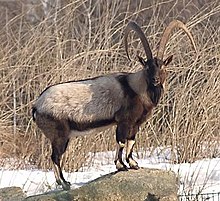Capra aegagrus aegagrus
| Bezoar ibex | |
|---|---|
 |
|
| bezoar ibex, Capra aegagrus aegagrus | |
| Scientific classification | |
| Kingdom: | Animalia |
| Phylum: | Chordata |
| Class: | Mammalia |
| Order: | Artiodactyla |
| Family: | Bovidae |
| Subfamily: | Caprinae |
| Genus: | Capra |
| Species: | C. aegagrus |
| Subspecies: | C. a. aegagrus |
| Trinomial name | |
|
Capra aegagrus aegagrus Erxleben, 1777 |
|
The bezoar ibex (Capra aegagrus aegagrus), also known as the Anatolian bezoar ibex, or Persian ibex is also known as a dağ keçisi by Anatolian locals. This ibex is a vulnerable subspecies of wild goat, native to Afghanistan, Armenia, Azerbaijan, Georgia, Iraq, Iran, Russia and Turkey. It has been extirpated from Lebanon, and has been introduced to the Florida Mountains of New Mexico.
The bezoar ibex is found in the mountains of Asia Minor and across the Middle East. It is also found on some Aegean islands and in Crete, where it is accepted that the goats constitute relict populations of very early domestic animals that were taken to the Mediterranean islands during the prehistoric period and now live as feral populations. The bezoar ibex, if not the sole progenitor of the modern domestic goat, is at least its main progenitor. The archaeological evidence traces goat domestication as far back as c. 10,500 years Before Present and DNA evidence suggests 10,000 years BP.
The bezoar ibex is known particularly for the size of its horns; they possess the world's longest horns in relation to body weight. Bezoars average about 60 kg (140 pounds) and their horns can grow as long as 1.5 m (55 in). Females are slightly smaller and their horns tend to grow to a mere 0.3 m (11 in). Males have a dark brown summer coat, while the females have a more reddish-gold, and both sexes shift to a gray-colored coat in the winter. Both sexes also have a "goatee", a tuft of hair extending from the chin. The ibexes have a black stripe from the spine that extends over the shoulder, limbs, and neck. This stripe darkens when the ibexes are in the mating season.
The bezoar ibex is a popular trophy hunt target. Numerous organizations have hunts targeted specifically for this ibex species. Hunting season is typically from the beginning of August to the end of March. The bezoar ibex, due to its high-altitude habitats and a tendency to thrive in rocky, inaccessible areas, is hunted with a spot-and-stalk method, usually over a period of several days. The bezoar ibex lives in steep hills, typically covered with forests and short bushes, starting from sea level at the Aegean Sea and extending up to an altitude of 3000 meters or about 9850 ft in eastern Turkey.
...
Wikipedia

